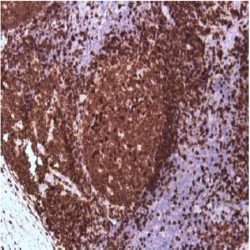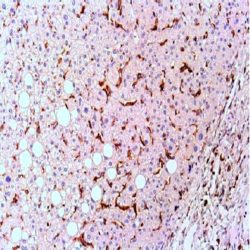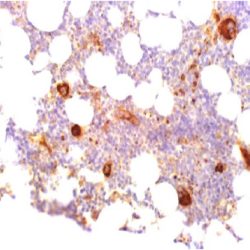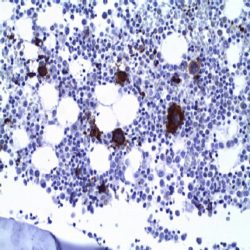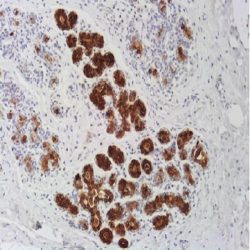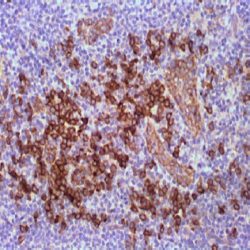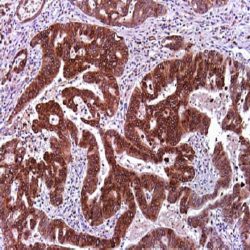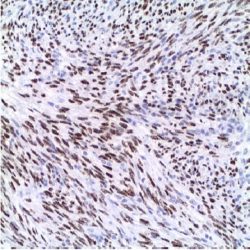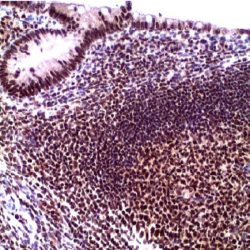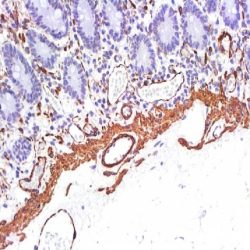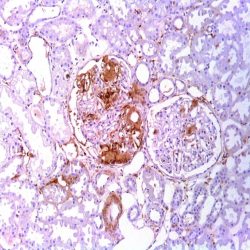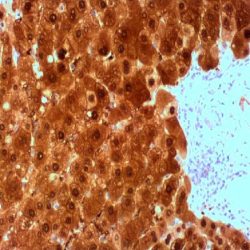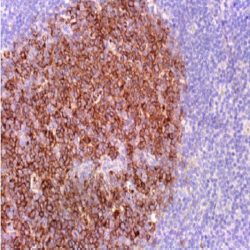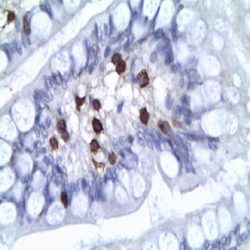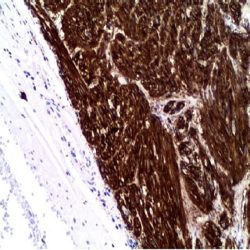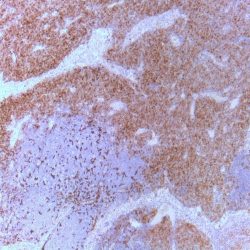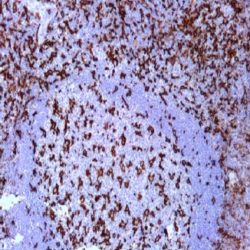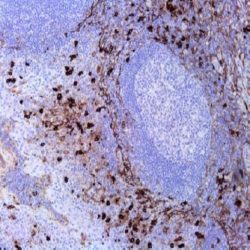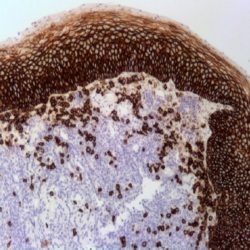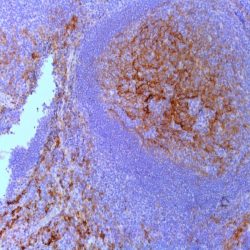مونوکلونال
نمایش 81–100 از 285 نتیجه
فیلتر ها-
آنتی بادیهای ایمونوهیستوشیمی
آنتی بادی CD79a/MB-1 (SP18)
امتیاز 0 از 5اطلاعات بیشترName: CD79a Antibody (Clone SP18)
Description and applications: A disulphide-linked heterodimer, consisting of CD79a/mb-1 and CD79b/B29 polypeptides, is non-covalently associated with membrane-bound immunoglobulins on B cells to constitute the B cell Ag receptor. CD79a first appears at pre B cell stage and persists until the plasma cell stage where it is found as an intracellular component. CD79a is an excellent marker of B cells and tumors derived therefrom, particularly useful for identifying infiltration by pre-B lymphomas and acute leukemias with intense plasmacytoid differentiation. T cell lymphomas and myeloid malignancies are consistently negative.
Composition: anti-human CD79a rabbit monoclonal antibody purified from ascites. Prepared in 10mM PBS, pH 7.4, with 0.2% BSA and 0.09% sodium azide.
Immunogen: Synthetic peptide derived from N-terminus region of human CD79a protein.
-
آنتی بادیهای ایمونوهیستوشیمی
آنتی بادی CD33 (PWS44)
امتیاز 0 از 5اطلاعات بیشترName: CD33 Monoclonal Antibody (Clone PWS44)
Description and applications: Clone PWS44 detects the CD33 antigen on the membrane and in the cytoplasm of cells of myelomonocytic lineages. In normal bone marrow trephine biopsies, clone PWS44 stains myeloid and myelomonocytic hemopoiesis and mature macrophages; cells of the erythroid and megakaryocytic series are negative. Some reactivity was observed in cytotrophoblasts and syncytiotrophoblasts of placenta. Except for dendritic cells and infiltrating macrophages, no staining was observed in other normal tissues evaluated. Clone PWS44 stained acute myeloid leukemias, chronic myeloid leukemia, granulocytic sarcomas and cases of myeloid dysplasia and myeloproliferative diseases. PWS44 stained cases of non-lymphoid tumours. In the lymphoid neoplasms tested CD33 staining was observed in precursor B-lymphoblastic leukemias, precursor T-lymphoblastic leukemias, classical Hodgkin’s lymphomas, Burkitt lymphomas, plasma cell neoplasms, hematodermic lymphoid neoplasms, anaplastic large cell lymphoma, lymphoplasmacytic lymphoma.
Composition: anti-human CD33 mouse monoclonal antibody purified from tissue culture supernatant. Prepared in 10mM PBS, pH 7.4, with 0.2% BSA and 0.09% sodium azide.
Immunogen: Prokaryotic recombinant protein corresponding to a region of the C2 domain of the human CD33 molecule.
-
آنتی بادیهای ایمونوهیستوشیمی
آنتی بادی CD42b (42C01)
امتیاز 0 از 5اطلاعات بیشترName: CD42b (42C01)
Description and applications: The CD42b glycoprotein, also known as GPIb, is a co-factor of ristocetin-induced aggregation and is involved in the binding of platelets to blood vessel walls. The CD42b antigen is expressed on platelets and on megakaryocytes in bone marrow. The absence of CD42b antigen on platelets may indicate Bernard-Soulier disease. The antibody is of value in the immunophenotyping of megakaryoblastic leukaemias that express one or more markers associated with platelets (CD41, CD61 and CD42b). In chronic myeloproliferative processes, like chronic idiopathic myelofibrosis in prefibrotic stage besides appearing in greater numbers the megakaryocytes are markedly abnormal while megakaryocytes in unclassifiable myelodysplastic / myeloproliferative diseases there is an increased of normal or small megakaryocytes (micromegakaryocytes).
Composition: anti-human CD42b mouse monoclonal antibody purified from the ascites fluid by Protein G chromatography. Prepared in 10mM PBS, pH 7.4, with 0.2% BSA and 0.09% sodium azide.
Immunogen: Recombinant CD42b.
-
آنتی بادیهای ایمونوهیستوشیمی
آنتی بادی CD61/GP-IIIa (2F2)
امتیاز 0 از 5اطلاعات بیشترName: CD61 Antibody (Clone 2F2)
Description and aplications: CD61 (GPIIIa) is a glycoprotein found on megakaryocytes, platelets and their precursors. CD61 antigen plays a role in platelet aggregation and also as a receptor for fibrinogen, fibronectin, von Willebrand factor and vitronectrin. This antibody is useful in detecting platelet precursors neoplasia, normal platelets and the majority of the megakaryocytic leukemia cases.
Composition: anti-human CD61 mouse monoclonal antibody purified from ascites. Prepared in 10mM PBS, pH 7.4, with 0.2% BSA and 0.09% sodium azide.
Immunogen: Recombinant protein encoding part of the external domain of human CD61.
-
آنتی بادیهای ایمونوهیستوشیمی
آنتی بادی Mammaglobin A & B (304-1A5 & 31A5)
امتیاز 0 از 5اطلاعات بیشترName: Mammaglobin Antibodies (Clones 304-1A5 & 31A5)
Description and applications: Mamoglobina is a 10 kDa glycoprotein associated to the breast and relacionada with the family of secretoglobinas which include uteroglobin and lipophilin. Mammaglobin is encoded by the gene MGB1 located on chromosome 11q12.3-q13. This chromosome is frequently amplified in breast carcinomas. As compared to normal breast more than 23% of primary breast carcinomas and 62% the metastases overexpress mammaglobin. Overexpression does not seem to be related to histology, hormone receptor expression, grade or tumor stage. Other tumors with focal or diffuse mammaglobin expression are endometrioid adenocarcinoma, cervical adenocarcinoma, salivary gland tumors, sweat gland tumors and some melanomas. Head and neck, thyroid, lung (adenocarcinoma, squamous), stomach, colon, pancreatic and ovarian tumors do not express mammaglobin. Compared to GCDFP-15, Mammaglobin has demonstrated higher sensitivity for identifying primary and metastatic breast tumors.
Composition: cocktail of anti-Mammaglobin antibodies obtained from supernatant culture and prediluted in a tris buffered solution pH 7.4 containing 0.375mM sodium azide solution as bacteriostatic and bactericidal.
-
آنتی بادیهای ایمونوهیستوشیمی
آنتی بادی CD123 (Interleukin-3 Receptor Alpha Chain) (7G3)
امتیاز 0 از 5اطلاعات بیشترName: CD123 (Interleukin-3 Receptor Alpha Chain) Antibody (Clone 7G3)
Description and applications: The 7G3 monoclonal antibody specifically reacts with human CD123, the 70 kDa IL-3 Receptor α (IL-3Rα) chain. CD123 associates with CD131, the 120-140 kDa Common β chain to form the IL-3 Receptor Complex. CD131 is shared with the receptors for interleukins IL-5 and GM-CSF. IL-3Rα is expressed on hematopoietic progenitors and plays an important role in hematopoietic progenitor cell growth and differentiation. It is also expressed by mast cells, macrophages and a CD5+ B cell subset. This antibody has been reported to block the binding of 125I-IL-3 to high and low affinity IL-3 receptors. In functional experiments, this antibody was found to inhibit acute myeloid leukemia cell proliferation, basophil histamine release, endothelial cell-mediated IL-8 secretion, and neutrophil transmigration.The antibody is useful in paraffin sections to identify plasmacytoid dendritic cells, a distinct lineage of dendritic cells which are considered to gives rise to the blastic plasmacytoid dendritic cell neoplasia (CD4 + / CD56 + / CD123 +) and acute leukemia of ambiguous lineage (CD4 + / CD56- / CD123 +). Plasmacytoid dendritic cells (CD123 +) can be found in clumps in ocational cases os myeloid sarcoma with inv (16) and in chronic myelomonocytic leukemia.
Composition: anti-human CD123 mouse monoclonal antibody purified from ascites. Prepared in 10mM PBS, pH 7.4, with 0.2% BSA and 0.09% sodium azide.
-
آنتی بادیهای ایمونوهیستوشیمی
آنتی بادی COX-2 (SP21)
امتیاز 0 از 5اطلاعات بیشترName: COX2 (Cyclooxygenase 2) Antibody (Clone SP21)
Description and applications: COX-2 (Cyclooxygenase-2) is an inducible enzyme. It is involved in the response of cells to growth factors, tumor promoters, and cytokines that induce its expression. Given its role in synthesizing prostaglandins, COX-2 is therefore of interest in studying immune response regulation. COX-2 is induced by a wide variety of stimuli and was initially identified as immediate-early growth response gene. In addition, COX-2 expression markedly increased in 85-90% of human colorectal adenocarcinoma whereas COX-1 levels remain unchanged. COX-2 is expressed in normal cells from mammary acini, uterine cervix, uterus, fallopian tubes, trophoblast of chorionic villi, prostate, seminal vesicles, epididymis, bladder urothelial epithelium, gastric glands or gallbladder. Consequently, COX-2 is expressed in many solid tumors. Intense to moderate cytoplasmic and sometimes membrane expression is observed in colorectal, prostate, cervical, endometrial, ovarian, urothelial, pancreatic and hepatic carcinomas. COX-2 is frequently expressed in breast carcinomas while up to 80% of pituitary adenomas are positive. The prognostic value of COX-2 expression is controversial.
Composition: anti-human COX2 rabbit monoclonal antibody purified by protein affinity and prepared in 10mM PBS, pH 7.4, with 0.2% BSA and 0.09% sodium azide.
Immunogen: Synthetic peptide corresponding to C-terminus of rat COX-2.
-
ایمونو هیستوشیمی
آنتی بادی Human Herpes Virus 8 (13B10)
امتیاز 0 از 5اطلاعات بیشترName: Herpes Virus 8 (HHV-8) Antibody (Clone 13B10)
Description and applications: Human herpesvirus type 8 (HHV-8) is the likely etiological agent of Kaposi’s sarcoma (KS). HHV-8 DNA sequences have been found in Kaposi’s sarcoma lesions, primary effusion lymphoma, and multicentric Castleman’s disease via polymerase chain reaction and in situ hybridization. Latent nuclear antigen (LNA-1, LNA, LANA-1), also known as ORF73, is a 222- or 234 kD protein that is consistently expressed in HHV-8 infected cells. Anti- HHV-8 labels the latent nuclear antigen protein via immunohistochemistry.
Composition: anti-HHV-8 mouse monoclonal antibody obtained from supernatant culture and prediluted in a tris buffered solution pH 7.4 containing 0.375mM sodium azide solution as bacteriostatic and bactericidal.
-
آنتی بادیهای ایمونوهیستوشیمی
آنتی بادی INI1 (BAF47/SNF5) (25/BAF47)
امتیاز 0 از 5اطلاعات بیشترName: INI-1 (BAF47/SNF5) Antibody (Clone 25/BAF47)
Description and applications: SWI/SNF complexes facilitate gene activation and transcription factor binding by altering repressive chromatin structures in an ATP-dependent manner. In mammals, SWI/SNF complexes are present in mutliple forms that include 9-12 BRG1-associated factors (BAFs) per complex. These BAF proteins range in molecular weight from 47 to 250 kDa. BAF47/SNF5 (SMARCB1/Ini1) complexes with BRG1- and BRM-containing SWI/SNF complexes. BAF47/SNF5 mRNA is widely expressed in cell lines and tissues, and BAF47/SNF5 gene is mutated in many human tumors. The latter is indicative of a tumor suppressor role for BAF47/SNF5. In addition, mice deficient for BAF47 die early in embryogenesis, while BAF47/SNF5 heterozygous mice display a variety of tumors in the soft tissues of the head and neck. BAF47/SNF5 also binds the HIV-1 integrase and stimulates integrase-mediated DNA joining activity. Thus, BAF47/SNF5 is a component of SWI/SNF complexes that may be critical for normal development and tumor suppression, but may also be a protein utilized for viral DNA integration into host DNA. Expression in normal tissues is ubiquitous. In tumor tissue loss of protein expression SMARCB1 / INI1 gene was first observed in all malignant rhabdoid tumors of childhood of different location (soft tissue, kidney and CNS) and in medullary carcinomas of the kidney. Also loss of expression is observed in 50% of synovial sarcomas, some myxoid chondrosarcoma and myoepithelial carcinomas, almost all epithelioid sarcoma (proximal and conventional variants) and 50% of malignant tumors of peripheral nerves sheat, all presenting rhabdoid morphology. Loss of immunohistochemistry expression is also observed in cases of poorly differentiated chordoma. The antibody is useful in differentiating rhabdoid tumors of other tumors with similar morphology as desmoplastic round cell tumor, rhabdomyosarcoma and Wilms tumor do not show loss of expression of INI1. The antibody also is useful in confirming the diagnosis of medullary carcinoma and discard possible renal pelvis urothelial carcinoma or other carcinomas of the kidney showing expression for INI1. Maintained staining in most carcinomas, epithelioid angiosarcoma, mesotheliomas, melanomas and other tumors or lesions reagents (granulomas) of epithelioid morphology make this useful antibody in the diagnosis of epithelioid sarcoma.
Composition: anti-human INI-1 mouse monoclonal antibody purified from serum and prepared in 10mM PBS, pH 7.4, with 0.2% BSA and 0.09% sodium azide.
Immunogen: mouse BAF47 aminoacids 257-359.
-
آنتی بادیهای ایمونوهیستوشیمی
آنتی بادی Actin, Muscle Specific (HHF35)
امتیاز 0 از 5اطلاعات بیشترName: Muscle Specific Actin,Antibody (Clone HHF35)
Description and applications: Actin is a major component of the cytoskeleton. This antibody recognizes actin of skeletal, cardiac, and smooth muscle cells. It is not reactive with other mesenchymal cells except for myoepithelium. Actin can be resolved on the basis of its isoelectric points into three distinctive components: alpha, beta and gamma in order of increasing isoelectric point. Anti- Muscle-Specific Actin recognizes alpha and gamma isotypes of all muscle groups. Non-muscle cells such as vascular endothelial cells and connective tissues are non-reactive. Also, neoplastic cells of non-musclederived tissue such as carcinomas, melanomas, and lymphomas are negative. This antibody is useful in the identification of rhabdoid cellular elements.
Composition: anti-human Muscle Specific Actin mouse monoclonal antibody purified from serum and prepared in 10mM PBS, pH 7.4, with 0.2% BSA and 0.09% sodium azide.
Immunogen: SDS extract of human myocardium
-
آنتی بادیهای ایمونوهیستوشیمی
آنتی بادی Amyloid P (EP1018Y)
امتیاز 0 از 5اطلاعات بیشترName: Amyloid P Antibody clone EP1018Y
Description and applications: Serum Amyloid P (SAP) is a non-fibrillar plasma glycoprotein that belongs to the pentraxin family. It is universally found in amyloid deposits and this is probably due to its specific calcium-dependent binding to motifs present on all types of amyloid fibrils. SAP is also found to prevent fibrillar breakdown by enzymes and it is believed that it helps maintains stability of the amyloid deposits. It has been shown that SAP binds monocytes with high avidity, but does not bind to erythrocytes, NK cells, T lymphocytes or B lymphocytes. SAP production can be induced by exposure to IL-1, IL-6 and IFN-beta. The SAP-inducing activity was neutralized by antibodies to each of the recombinant cytokines. Recognition of these type of amyloid has prognostic and therapeutic implications. The increase in SAP secretion has been documented in different pathologies including neoplasms, rheumatoid arthritis
and CNS diseases. The synthesis of SAP is increased in systemic amyloidosis and is a common component in amyloid deposits. SAP has also been identified in arteriosclerotic lesions.Composition: Anti-human Amyloid P rabbit monoclonal antibody purified from serum and prepared in 10mM PBS, pH 7.4, with 0.2% BSA and 0.09% sodium azide.
-
آنتی بادیهای ایمونوهیستوشیمی
آنتی بادی ARG-1 (EP261)
امتیاز 0 از 5اطلاعات بیشترName: Arginase-1 Antibody (Clone EP261)
Description and applications: Arginase is a manganese metalloenzyme that catalyzes the hydrolysis of arginine to generate ornithine and urea. Arginiase I and II are isoenzymes which differ in subcellular localization, regulation, and possibly function. Arginase I is a cytosolic enzyme, which is expressed mainly in the liver as part of the urea cycle, whereas arginase II is a mitochondrial protein found in a variety of tissues. Antibody to ARG-1 labels hepatocytes in normal tissues and granulocytes in peripheral blood. ARG-1 is a sensitive and specific marker for identification of hepatocellular carcinoma. This antibody is very useful in distinguishing between: 1) liver metastases of various adenocarcinomas and hepatocellular carcinoma (HCC), which can be a realdiagnostic challenge, especially in small biopsies or material from fine needle aspiration ( FNA) and 2) the distinction between different histological variants of HCC and cholangiocarcinoma. Specifically, the ARG-1 antibody is key in the diagnosis of scirrhous hepatocellular carcinoma, where specific markers for adenocarcinomas are generally positive while HepPar-1 in some cases it may be negative. In addition, several studies have shown that ARG-1 antibody is more sensitive than HepPar-1 for immunohistochemical diagnosis of hepatocellular carcinoma while the second is usually negative in poorly differentiated hepatocellular carcinomas and can be positive in adenocarcinomas of pancreatic, gastric, colic origin or even cholangiocarcinoma. However, isolated cases of pancreatic adenocarcinomas and cholangiocarcinomas presented focal staining against ARG-1. In this line, it should be considered that the ARG-1 antibody does not allow differential diagnosis between benign, dysplastic and malignant hepatocyte lesions.
Composition: anti-human ARG-1 rabbit monoclonal antibody purified from serum and prepared in 10mM PBS, pH 7.4, with 0.2% BSA and 0.09% sodium azide.
-
آنتی بادیهای ایمونوهیستوشیمی
آنتی بادی CD10 (56C6)
امتیاز 0 از 5اطلاعات بیشترName: CD10 Antibody (Clone 56C6)
Description and aplications: CD10, also known as Common Acute Lymphocytic Leukemia Antigen (CALLA), is a cell surface enzyme with neutral metalloendopeptidase activity which inactivates a variety of biologically active peptides. CD10 is expressed on the cells of lymphoblastic, Burkitt’s, and follicular germinal center lymphomas, and on cells from patients with chronic myelocytic leukemia (CML). It is also expressed on the surface of normal early lymphoid progenitor cells, immature B cells within adult bone marrow and germinal center B cells within lymphoid tissue. CD10 is also present on breast myoepithelial cells, bile canaliculi, fibroblasts, with especially high expression on the brush border of kidney and gut epithelial cells.
Composition: anti-human CD10 mouse monoclonal antibody purified from ascites fluid by Protein A chromatography. Prepared in 10mM PBS, pH 7.4, with 0.2% BSA and 0.09% sodium azide.
-
آنتی بادیهای ایمونوهیستوشیمی
آنتی بادی CD103 (EP206)
امتیاز 0 از 5اطلاعات بیشترName: CD103 Antibody (Clone EP206)
Description and applications: CD103, also known as integrin alpha E (ITGAE), is an integrin protein that in humans is encoded by the ITGAE gene. It binds integrin beta 7 to form the complete heterodimeric molecular αEβ7 that binds to an extracellular matrix component and cellular counter receptor. They mediate cell adhesion, migration and signaling and are important for T lymphocyte localization. CD103 is expressed on intraepithelial lymphocytes in mucosal areas, including lung and GI tract. In malignancies, CD103 is present on all enteropathy-type T-cell lymphomas. Additionally, CD103 has been a useful marker for hairy cell leukemia.
Composition: anti-human CD130 rabbit monoclonal antibody purified from ascites. Prepared in 10mM PBS, pH 7.4, with 0.2% BSA and 0.09% sodium azide.
-
آنتی بادیهای ایمونوهیستوشیمی
آنتی بادی CD117/c-kit (EP10)
امتیاز 0 از 5اطلاعات بیشترName: CD117/c-kit Antibody (Clone EP10)
Description and applications: This antibody reacts with human oncoprotein c-kit (CD117). The proto-oncogene c-kit encodes a transmembrane receptor with tyrosine kinase activity, c-kit (CD117), which is closely related to the family of platelet derived growth factor receptors. c-KIT is involved in hematopoiesis, gametogenesis and melanogenesis. This antigen is expressed in the normal breast epithelium, melanocytes, mast cells and glia. This antibody is recommended to identify oncoprotein expression c-kit in a variety of normal and neoplastic tissues, including gastrointestinal stromal tumors (GIST). It is also expressed in testicular seminoma, small cell carcinomas of the lung, breast carcinomas, glioblastomas, melanomas, and chronicmyeloid leukemias or acute myeloid leukemias in myeloid blast crisis.
Composition: anti-human CD117/c-kit rabbit monoclonal antibody purified from ascites. Prepared in 10mM PBS, pH 7.4, with 0.2% BSA and 0.09% sodium azide.
-
آنتی بادیهای ایمونوهیستوشیمی
آنتی بادی CD11b (Integrin Alpha-M) (EP45)
امتیاز 0 از 5اطلاعات بیشترName: CD11b (Integrin Alpha-M) Antibody (Clone EP45)
Description and applications: Integrin alpha-M (ITAM, ITGAM, CD11b, Mac-1 alpha subunit, C3 alpha chain) is the alpha subunit of the ITAM/beta-2 complex, also named CD11b/CD18 or Mac-1, a leukocyte adhesion heterodimeric glycoprotein. CD11b is involved in monocyte, macrophage, and granulocyte adhesion. CD11b is mainly expressed in myeloid cells of human origin, NK1 cells, monocytes, and granulocytes. In neoplasms, CD11b is useful for the identification of acute myeloid leukaemias (AML) (AML with inv(16) or t(16;16), AML with 11q23/MLL abnormalities, myeloblastic AML with minimal differentiation, myelomonocytic AML, acute monoblastic leukaemia, and acute monocytic leukaemia), where blasts may express CD11b among other molecules of monocytic differentiation. CD11b is also expressed in T-cell large granular lymphocyte leukaemias and in aggressive NKcell leukaemias.
Composition: Anti-human CD11b (Integrin Alpha-M) rabbit monoclonal antibody purified from serum and prepared in 10mM PBS, pH 7.4, with 0.2% BSA and 0.09% sodium azide.
-
آنتی بادیهای ایمونوهیستوشیمی
آنتی بادی CD11c (Integrin Alpha-X) (EP157)
امتیاز 0 از 5اطلاعات بیشترName: CD11c (Integrin Alpha-X) Antibody (Clone EP157)
Description and applications: CD11c (ITGAX), a member of the leukointegrin family, shares the same beta subunit with other members of the leukocyte adhesion molecule family, which includes CD11a (LFA-1), CD11b (MAC-1) and CD11d (ITGAD), but has a unique alpha chain. CD11c has been shown to play a role in phagocytosis, cell migration, and cytokine production by monocytes/macrophages as well as induction of T cell proliferation by Langerhans cells. CD11c is expressed prominently on the plasma membranes of monocytes, tissue macrophages, NK cells, and most dendritic cells (DCs). A lower level of expression is also observed on neutrophils as a result of its high level of expression on most DCs. An antibody to CD11c may aid in identification of lesions with histiocytic origin. It may also been used as a marker for hairy cell leukaemia in paraffin embedded tissues.
Composition: anti-human CD11c rabbit monoclonal antibody purified from serum and prepared in 10mM PBS, pH 7.4, with 0.2% BSA and 0.09% sodium azide.
-
آنتی بادیهای ایمونوهیستوشیمی
آنتی بادی CD13 (EP117)
امتیاز 0 از 5اطلاعات بیشترName: Rabbit anti-human CD13 Monoclonal Antibody
Composition: anti-human CD13 rabbit monoclonal antibody purified from ascites fluid by chromatography. Prepared in 10mM PBS, pH 7.4, with 0.2% BSA and 0.09% sodium azide
Intended use: Immunohistochemistry (IHC) on paraffin embedded tissues. Not tested on frozen tissues or Western-Blotting
Immunogen: A synthetic peptide corresponding to residues in human CD13 protein
Visualization: Cell membrane
-
آنتی بادیهای ایمونوهیستوشیمی
آنتی بادی CD138 (EP201)
امتیاز 0 از 5اطلاعات بیشترName:CD138 Antibody clone EP201
Description and applications: CD138, also known as Syndecan-1, is a member of the transmembrane heparan sulfate proteoglycan family, acts as an extracellular matrix receptor and is involved in many cellular functions, including cell-cell adhesion and cell-matrix adhesion. CD138 expression is found in both hematopoietic and non-hematopoietic cells. In the hematopoietic system, CD138 labels plasma cells. It is an excellent marker for plasmacytic differentiation within the spectrum of hematologic malignancy. It´s a very usefull tool in the diagnostic of chronic endometritis associated with infertility. Among nonhematolymphoid cells, CD138 reactivity is observed inmany types of epithelial cells and stoma cells in both normal and tumor tissues. These staining should
be remembered and not interpreted as unspecific.Composition:Anti-human CD138 rabbit monoclonal antibody purified from serum and prepared in 10mM PBS, pH
7.4, with 0.2% BSA and 0.09% sodium azideIntended use: Immunohistochemistry (IHC) on paraffin embedded tissues. Not tested on frozen tissues or Western-Blotting
-
آنتی بادیهای ایمونوهیستوشیمی
آنتی بادی CD14 (EP128)
امتیاز 0 از 5اطلاعات بیشترName: CD14 Antibody (Clone EP128)
Description and applications:CD14 is a 55-kDa protein found as a glycosylphosphatidylinositol (GPI)- anchored protein on the surface of monocytes, macrophages, and polymorphonuclear leukocytes, and as a soluble protein in the blood. Its main function is to serve as a receptor for lipopolysaccharide (LPS). Besides its role in endotoxin signaling, it has been proposed that CD14 is involved in the transportation of other lipids, cell-cell interactions during different immune responses, and recognition of apoptotic cells.
CD14 is highly expressed on the surface of monocytes/macrophages and strongly up-regulated during the differentiation of monocytic precursor cells into mature monocytes. Therefore, CD14 has been commonly used as a differentiation marker for monocytes/macrophages. An antibody to CD14 also labels Langerhans cells and dendritic cells.Composition: Anti-human CD14 rabbit monoclonal antibody purified from serum and prepared in 10mM PBS, pH 7.4, with 0.2% BSA and 0.09% sodium azide.

